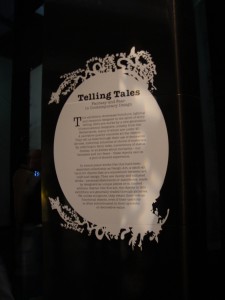
Outside the 'Telling Tales' exhibit
There were many things I adored about the V&A museum: the entrance way of marble Greek sculptures, the fashion wing including one of Princess Diana’s dresses. But what took my breath away the most was the fairy tale exhibit, Telling Tales. As many of you know, I have a childlike obsession with fairy tales and Disney movies, especially the Little Mermaid. But it is not the Disney story or the catchy songs that make me love these stories even as the years go by, but rather the way that these stories can transform a young child’s hopes and dreams into a story that suspends reality. These stories create a new world where children can hide for a little while. Who wouldn’t love that?
Well the Telling Tales exhibit at the V&A museum did just that: suspend reality and take the audience into a magical fantasy world. The works of art on display were amazing manifestations of the classical fairytales in furniture and sculpture. But that was not even the best part of the exhibit, rather it was the way that entire space was like a fairytale. Each room followed a different theme: the forest glade, the enchanted castle, and heaven and hell. To say that each of these rooms’ atmospheres matched their titles would be an understatement. When I entered the first room, the enchanted forest, all the walls and lighting matched that of a forest. It was likewise for each room. With this, the exhibit was able to achieve exactly what a fairytale is meant to: suspend reality.
The V&A museum mostly deals with exhibitions about design. Besides the suspension of reality, this show captures the elements of fairytales: dreams, hope, fear, beauty, and of course happy endings. Although the exhibit ended darkly with the heaven and hell room, I think in this way it remained grounded in realtiy. Afterall, we are not in a fairytale. And eventually the suspension of reality ends. And what better place to end it than with death, where everything ultimately ends?
Note: Photo slideshow of the V&A museum to come soon. However the Teling Tales Exhibit did not allow photography inside.
Tags: Megan · Museums
September 4th, 2009 · 1 Comment
It would be easy to provide a thoughtful, all-encompassing understanding of museums in London. I have tried to give some idea of the sprawling elegance of the National Gallery and National Portrait Gallery, the comparative edge provided by the Tate Modern, and the gaping expanse filled by the British Museum. All inspire and churn the mind (or stomach) in different ways. Yet it would be foolhardy to say you can provide an “easy” nor “all-encompassing” understanding of museums in London (not that anyone has, necessarily). A double-threat stands in your way—The Victoria and Albert Museum and the Sir John Soane’s Museum.
I walked away from both of these buildings baffled. It took much effort not to dismiss the V&A as immediately nonsensical, so I settled on “eclectic” as the best way to describe it. The V&A has been described in previous posts as an enjoyable hodgepodge of items without ties to anything distinctly British and breaking from any sort of natural organization. I agree with these perceptions of the museum, though it did, admittedly, take some time for me to reach this conclusion. I enjoyed the individual displays, but I got caught up with the confusing flow of the individual displays and the building as a whole. The display dedicated to Japan, for instance, did not contain a natural progression of Japanese art; a piece of art from the 21st century rested in the same case as centuries-old clothing. How does this make sense? Is the purpose to jolt the accepted model for museums? I have asked others and myself these questions and have come to appreciate the fresh perspective held by the V&A. It purposefully provides a jolt, but it takes varying amounts of time to recover, reflect, and, ultimately, revisit.
That in mind, I have yet to recover from the Sir John Soane’s Museum.
The history of the museum gives some indication of what to expect from the famed architect Sir John Soane and his conversion of his home into a museum in the 19th century. The collection was impressive in size and range – sculptures, paintings, books, furniture, pottery, figurines, etc. Once again, I appreciated the attention paid to detail in the cataloguing and presentation of the items, but I got caught up with the following questions: Why is this here? Why is this important? Who would benefit from this? I did not learn very much from the museum. (This does not include my sudden, pressing need to redefine my understanding of the word “museum”.) Granted, this may have been a result of the ‘jolt’ provided by walls lined with statues and other artifacts with little to no descriptors. Accustomed to the museum model that gave you some indication of what you viewed, I never took the initiative to ask more about the items lining every square inch of the walls. (I should mention here that the V&A did maintain this model.)
So, I try to assign a new word to describe this outlier of sorts. ‘Eclectic’ cannot apply to this museum, for a common theme of antiquity and classicism prevailed despite the range of the items. ‘Nonsensical’ does not apply either, for Soane had a set purpose in designing the museum for students (the education portion of the museum continues to this day).
For now, I will settle on ‘unusual’ and ‘out of place’ as ways to show Soane’s Museum as an outlier that expands the range of museums in London. The V&A did fall into this category when taken at face value. Perhaps I will come to the same conclusions when reflecting on Soane’s Museum.
Moreover, I hope to come to some conclusions about what each museum has to say about one’s British identity/identity in London, whether or not that is the museum’s immediate goal. This is a question that I have seen in previous posts but I have not been able to answer. I welcome your thoughts on either of these museums or your ideas on the role played by museums in shaping identity (if you’ve begun to formulate them…I cannot get my head around it just yet).
Tags: Brandon
-
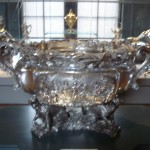
-
Giant Silver Punch Bowl at the V&A
-
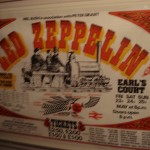
-
The Theatre and Stage Exhibit at the V&A
-
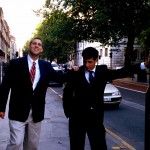
-
Brandon and I before Arcadia
-
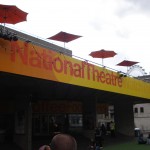
-
Outside the National Theatre
This Monday I experienced my first bank holiday. Because of our full schedule here this month it didn’t seem any different from any other day here. This held true until I wandered down Tottenham Court Road and realized that just about everything was closed. With just a handful of museums open I decided to use the time to visit one I hadn’t been to yet: The Victoria and Albert Museum.
I had been told great things about the V&A museum by classmates who had been there within the past few days so I went in with pretty high expectations. After seeing the first exhibit based on Great Britain from the 1600’s-1800’s I was not impressed. Boy would this opinion change. I walked up to the first floor and entered a giant gallery filled with all kinds of sculptures. This was easily the best sculpture gallery I had seen so far in London and I spent about 15 minutes walking through it and admiring. As I continued to walk through the entirety of the first floor I was absolutely astounded by the variety of exhibits this museum had to offer. Some highlights included a detailed exhibit on fashion, a room filled with giant monuments including a cross and decorative pillars and an exhibit on the Middle East and its textiles.
After a good hour spent on the first floor I ventured up to the third floor of the museum. As soon as I stepped into the silver exhibit I was in awe. I spent at least a half an hour admiring and studying silver used and manufactured in different time periods and parts of the world. My favourite was a giant punch bowl made entirely of silver. There were many other exciting exhibits on the third floor including one on theatre and a print exhibit featuring one of my late grandmother’s favorite authors, Beatrix Potter. My last stop on the third floor was the jewelry exhibit. In addition to being aesthetically pleasing the exhibit featured a timeline of jewelry that was considered fashionable since the start 18th century and a few small personal collections.
I could have spent at least another three hours in the Victoria and Albert museum but I decided to hold off for another day. The thing that impressed me the most about this museum was the variety of exhibits. Just about every other museum I had visited so far in London I knew what to expect going in. The V&A featured anything and everything and had no qualms about doing so. I found this both refreshing and exciting.
The rest of my bank holiday was filled with a trip to the theatre. Upon request the entire class got “dolled up” for a performance at the Duke of York’s Theatre near Leicester Square. We saw Arcadia, a Tom Stoppard play that turned out to be both extremely funny and thoughtful. The class seemed a bit skeptical of how the play would be at first glance since we couldn’t see much of the stage but as soon as the curtain went up things improved immediately. Neil Pearson’s performance as Bernard Nightingale was unmatched and fit perfectly with Samantha Bond’s character of Hannah Jarvis. The play was not only entertaining and made me think but also fit in perfectly with our program since it contrasted the humanities and sciences.
Ever since seeing Troilus and Cressida last Friday I have been craving anything to do with the theatre. This happened to be perfect timing as we spent all of Tuesday focusing on the stage. In the morning we had a fantastic conversation with Rick Fisher , a Dickinson alum of 1979 and a recipient of two Tony Awards, most recently for his work on Billy Elliot: The Musical. It was fascinating speaking with a Dickinson graduate who had simply worked his way up from the very bottom of the London theatre scene.
In the afternoon the class toured the National Theatre. Our tour guide took us through all parts of the building including the three main theaters. The Olivier, which is the largest, seats about 1100 people and does not have a bad seat in the house. My favorite part about the Olivier was that the main stage could be divided in half and raised and lowered at any time. In addition to the Olivier we also viewed the Cottesloe Theatre a black box that has the capability of being transformed into just about anything. All of the chairs in front of the stage can fold down and the risers they sit on can be pushed in creating additional stage space. The tour guide described a play that had been recently performed in the Cottesloe where the actors were mixed in with the audience. This amazed me. We also viewed the Lytellton Theatre where our class will be viewing the Pitmen Painters together next week. The other part of the tour that really amazed me was the props department. From the crocodile in Peter Pan to a severed head no prop was impossible to create.
After the tour of the National Theatre many of us were so excited about coming back that we decided to go see Shakespeare’s All’s Well That End’s Well, the play taking place in the Olivier currently. My reaction to the play was mixed. The theatre itself was amazing. The props, sets and lighting blew my mind and the acting was good overall. Despite all of these positives I didn’t particularly enjoy the actual play, especially the ending. It seemed impractical to me and unlikely to happen in real life, even 500 years ago.
Overall learning about theatre in London has been a lot of fun. In addition to seeing a variety of shows we’ve gotten a chance to see London theatre from many different perspectives. From the traditional globe experience to hearing about small fringe productions from Rick Fisher to a tour of all three main facilities at the National Theatre we have received a wide perspective of how this popular activity has influenced the city as a whole and in all different ways, shapes and forms.
Tags: Henry · Museums · Theatre





